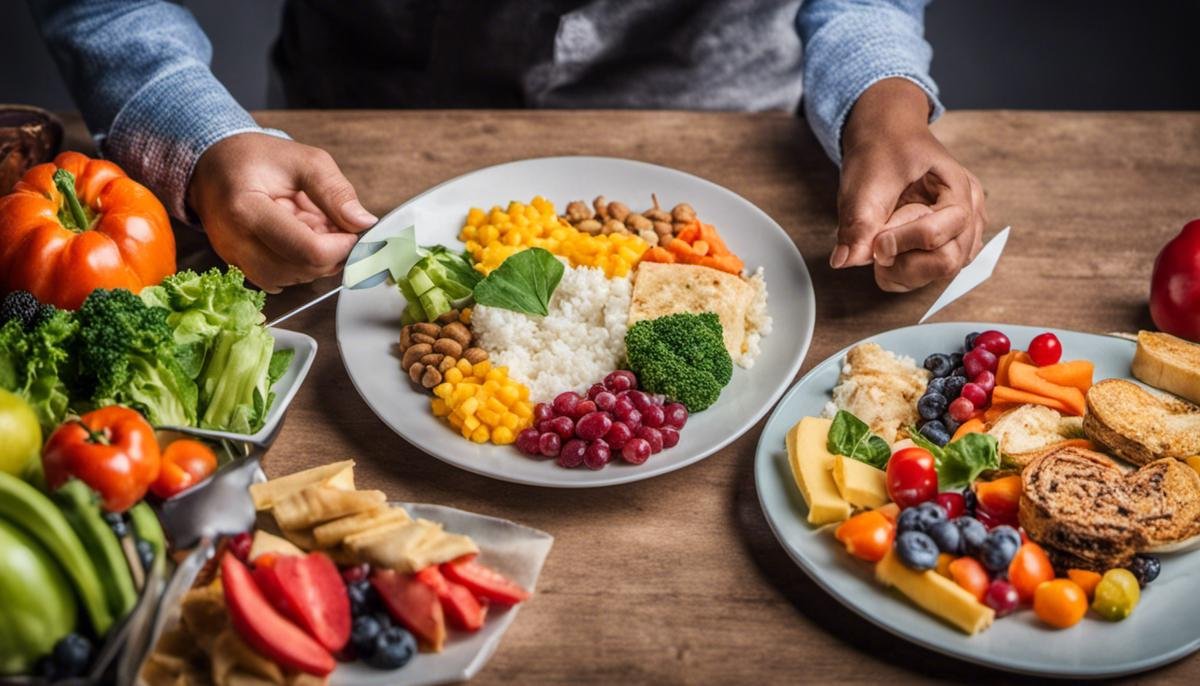
Autism is a complex neurological disorder that can affect individuals differently, often influencing individuals’ sensory perceptions. A common manifestation is sensitivity when it comes to the textures, tastes, and colors of food, often leading to selectivity and even aversion to certain types of foods. This unique food response can make mealtimes challenging, but with knowledge and understanding of the underlying roots of these challenges, solutions can be crafted more effectively. This delve will embark on a journey to understand autism and food sensitivities, behavioral techniques for introducing new foods, and the art of preparing and presenting food to make it more appealing to autistic individuals.
Understanding Autism and Food Sensitivities
Headline: Sensitivities to Certain Foods: Exploring the Link with Autism
Autism is an intricate neurological condition that affects life in numerous ways for countless individuals around the globe. While these intrepid souls navigate their individualism and uniqueness, they also have to deal with certain adverse elements. One such element is the noticeable sensitivity to certain foods that many people with autism seem to experience.
It’s essential to unravel this mysterious connection to improve the quality of life for those close to us, living with Autism Spectrum Disorders (ASD). So let’s take a shared journey exploring the connection between autism and food sensitivities.
First, let’s consider the fact that food sensitivity does not mean food allergy. It’s crucial to realise that while some people with autism may have food allergies, most often we are dealing with food intolerance or sensitivity. This primarily impacts the digestive system, leading to discomfort after eating certain foods, but does not trigger the immune system, like allergies do.
Now, you might be asking, “Why is food sensitivity more common in individuals with autism?”
Research suggests that this link might revolve around the gut-brain axis. This connection between the nervous system and the digestive system plays an essential role in modulating our behaviour and emotions. Many people with autism have reported gastrointestinal (GI) issues. These GI complaints and the resulting food sensitivities could be a manifestation of the disruption of this gut-brain interaction.
Moreover, studies indicate that a child with autism might be more likely to react negatively to certain foods due to an overgrowth of harmful gut bacteria. These bacteria can potentially produce harmful compounds when they come into contact with certain foods, leading to discomfort and food sensitivities.
Still wondering what kind of food sensitivities are we talking about?
Gluten and casein sensitivities are particularly reported in individuals with autism. Gluten is a protein found in grains like wheat, barley, and rye, whereas casein is present in dairy products. But remember, it’s essential to get a confirmed diagnosis by a health professional before eliminating these from the diet, as nutritional balance is vital to overall health.
In conclusion, the demonstrated connection between autism and food sensitivities isn’t definitively understood, but exploring it further offers us the opportunity to provide better care and support for those with autism. Always remember that each person with autism is unique and may not experience these food intolerances. It is not a blanket statement but a pattern recognized through observations and studies.
Remember, our goal is always to make their world easier—keep loving, keep supporting, and most importantly, keep learning! Our actions and choices as caregivers, parents, and guides can indeed make a world of difference. Enjoy mealtime as a joyous event, respecting individual needs, and offering understanding when sensitivities arise. Food can be enjoyment, comfort, and nourishment, for everyone at your table.

Behavioral Techniques for Introducing New Foods
Parents of autistic children frequently face the challenge of encouraging their little ones to try new foods, particularly when sensory sensitivities are involved. However, there are several behavioral techniques that can prove beneficial.
One effective method is the ‘Gradual Exposure’ technique. This method, as the name suggests, involves progressively introducing your child to new foods by incorporating them into meals on a gradual basis. Initially, the new food might merely rest on the same plate as their favorite meal – no pressure to consume it. Over time, they can be encouraged to touch, smell and eventually taste the novel food item. This slow and steady approach respects your child’s individuality and allows their sensory system time to adapt.
‘Modeling’ is another helpful technique. By observing other members of the family enjoy a wide range of foods, your picky eater might feel encouraged to give it a go. Positive reinforcement is key here! Celebrate little victories like a new food touched or tasted. This promotes a positive association with the experience of trying new foods.
A ‘Scheduled Menu’ can also be advantageous. Implementing a consistent meal and snack schedule may help eliminate stress or anxiety about what and when your child will eat next. This regularity can help ease the potentially overwhelming experience of being introduced to new foods.
‘Dish Presentation’ also plays an all-too-often overlooked role. A meal that’s visually appealing can pique your child’s curiosity and willingness to try new items. Think colorful fruits and veggies arranged into fun shapes alongside familiar favorites.
Finally, ‘Food Exploration’ can do wonders. Allow your child to become familiar with new foods outside of mealtime. This might entail getting hands-on and squishing a new fruit or arranging vegetables into a pattern. This form of play allows a child to build a relationship with new food in an arguably less stressful setting compared to the dinner table.
Each of these behavioral techniques has proven effective for many families, but it’s crucial to remember that each child has unique sensory needs and preferences. The success of their new food journey largely depends on patience, perseverance, and positive encouragement. Happy experimenting!
Remember, resilience and love go a long way in building a happy, healthy relationship between your child and the world of food.

Preparation and Presentation of New Foods
The World of Food: An Adventure for Autistic Individuals
Food – it’s one of the most basic needs, an art, and for some, a therapy. Navigating the world of food sensitivities with autism, wearing the ‘chef’s hat’ with patience and resilience can bring about transformative changes. The process is more than just cooking; it’s about creating an experience that embraces food with ease, combining techniques of presentation, exploration, and gradual exposure.
One important technique to consider is gradual exposure. Draping the unfamiliar in the cloak of familiarity, this technique helps in gradually introducing new foods. Start by introducing new foods alongside their favorite ones. Remember, it’s okay if they initially reject it. Consistent introduction over time, even without consuming, can help them grow familiar and build acceptance towards the new food.
Along with exposure comes the power of modeling. Young minds are impressionable and seek to mirror behaviors they often see. Demonstrating how to interact with new foods positively can be more influential than words. When they see you savoring a new food, their curiosity may pique, and a barrier might just come down.
Building a scheduled menu can create a comforting routine for the child. But, it can also serve as a guide to gradually incorporate new foods. This visual roadmap can help reduce anxiety related to unknown meals and create a sense of excitement.
But, will the new food be welcomed just by appearing on a plate? The answer lies in the presentation. Don’t underestimate the power of a well-presented meal. Turning the plates into a canvas, using colorful ingredients, can ignite curiosity. Experiment with different shapes, sizes or even food art. Let’s make new foods unexpected heroes on a familiar landscape.
Food exploration is an equally crucial aspect. The texture, temperature, color, or even sound of food plays a significant role in how it’s perceived. Involve them in meal preparation, let them touch, smell, and feel the food. Learning about it can ease their anxieties and develop familiarity.
All these tips and tricks boil down to one thing: fostering a positive relationship with food. Be patient and persistent; not every attempt will be a victory, but each step is important. Positive encouragement can go a long way in making them feel understood and comfortable. Celebrate little achievements, and make this journey enjoyable rather than stressful.
Remember, resilience is key. You are not alone in this journey. There are support groups, dieticians, and therapists willing to help you navigate these waters. Envelop your child with unconditional love, and believe in them. They are learning and growing at their own pace.
Every child with autism is unique – with their love for certain foods and their hesitance toward others. An understanding heart, ingenious strategies, and concerted efforts can help embolden them to say ‘hello’ to new foods. It’s time to make meals not just about eating, but about exploration, enjoyment, and positivity.

Introducing new foods to autistic individuals, especially those with picky eating habits, can be an uphill task, but not impossible. A greater understanding of autism and its implications on food preferences, coupled with innovative behavioral techniques, can make the experience significantly smoother. The key lies in tailoring the process to the individual’s unique preference, which often includes playing around with colors, textures, and presentation styles. Remember, there is no one-size-fits-all solution. Each individual with autism is unique, and as such, their food preferences will be too. Successful introduction of new food will require patience, creativity, empathy, and above all, an understanding of this uniqueness.




